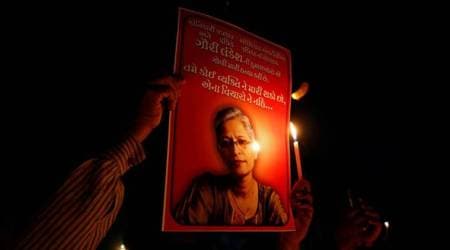 The PM can follow anyone he chooses to, but he must know that he lends enormous weight to the voices of those he singles out.
The PM can follow anyone he chooses to, but he must know that he lends enormous weight to the voices of those he singles out.
You are judged by the company you keep. The dictum applies with special force to India’s Prime Minister, who is followed by 33.8 million, but follows only 1,779 — some of whom drew attention with celebratory hate messages following the murder in Bengaluru of journalist and publisher Gauri Lankesh. The PM can follow anyone he chooses to, but he must know that he lends enormous weight to the voices of those he singles out for attention in his busy schedule and that they in turn can claim to speak for him. After Lankesh’s murder, one of them tweeted: “Ek kutiya kutte ki maut kya mari, saare pille ek sur mein bilbila rahe hain (a bitch has died a dog’s death and the litter is mourning)”. The pro-free speech argument offered in defence by BJP IT cell chief Amit Malviya has only intensified the embarrassment. Incidentally, following Lankesh’s conviction in a defamation case, he had tweeted: “Hope other journos take note.” The threat was duly noted and derided.
In his statement in defence of the PM’s life online, Malviya dismisses the controversy which has erupted on social media as “mischievous and contorted”. On the contrary, his exertions to escape its coils feature Houdini-like contortions — which fail to find release, nevertheless. “PM following someone is not a character certificate,” he argues. But it is, in practice, and he surely knows it. Right-wing advocates whom the PM follows display it proudly on their profiles, as an endorsement of their efforts, which may extend to hate speech, misogyny, violent threats and unspeakably bad language. Malviya says that the PM also follows Rahul Gandhi and Arvind Kejriwal. Of course he should, and this has no bearing on the criticism he and his social media managers are facing. In fact, he should follow every major political leader and people who play key roles in administration, academia, foreign policy and science.
But it is the free speech argument — that the PM supports dialogue by not unfollowing or blocking anyone — which shows up Malviya the most. Following on Twitter is a matter of choice. The Twitter user presses the “follow” button without prompting. It must be assumed that he or she liked what was on the screen. That assumption can be dispelled only by unfollowing, without recourse to the crutch of free speech arguments. Unfollowing is not a censorship tool. It does not prevent others from hearing what the person unfollowed has to say. Ordinary citizens are sensitive about whom they follow, because it determines perceptions about what they stand for. A prime minister should be particularly circumspect, and not allow his or her image to be tainted by association. When hate speech reaches a pitch at which murder, maiming or rape is either championed or celebrated, a line must be drawn. Following the killing of Gauri Lankesh, that line was crossed by the celebrants who are followed by the Prime Minister.

